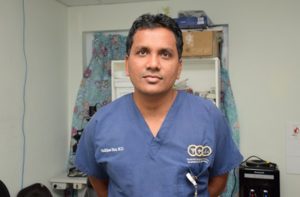…as emergency responders continue to breathe life into the health system
By Rehana Ahamad
MEDICAL resuscitations outside of a hospital in Guyana is not a regular occurrence because most medical emergencies here, including road accidents, are responded to by public-spirited citizens with no medical background, and more often than not, a person who is not breathing, is already considered dead – a lost cause.

Ordinarily, if a family wakes up to find one of its members not breathing, tears would come, followed by a hearse. But since the establishment of Guyana’s Emergency Medical Services (EMS), four persons have been successfully resuscitated even before they could reach the hospital. This accomplishment alone has underscored the need for the expansion and continued development of the EMS, the brainchild of Dr. Zulfikar Bux.
Since its implementation in 2016, the National EMS has responded to approximately 15,630 medical emergencies that have been reported via the ‘912’ emergency hotline. The challenge, however, is that a large section of the population is unaware of these services that can be accessed via the 912 hotline. “Numerous lives were saved and there has been a positive impact on pre-hospital emergency response locally,” Dr. Bux told the Guyana Chronicle during a recent interview.
Despite a host of limited resources and infrastructure, Emergency Medical Technicians (EMTs) have been able to successfully deliver 17 babies, en-route to the hospital. Admittedly, babies being delivered outside of a hospital is nothing out of the ordinary, however, its frequency dates back to a few decades ago when our grandmothers and great-grandmothers were all chefs and midwives in the making.
As the years passed, not too many of us can claim to be as skilled as they were, so our first instinct when a pregnant woman “tek in to get she baby” is to secure transportation to the hospital, most commonly, a taxi. Dr. Bux said that while the Emergency Medical Services have been reaping benefits in Region Four, there is a dire need for it to be expanded adequately throughout the country.
“This service has proven its worth worldwide and helps to save so many lives and we are seeing similar effects in Guyana. We want to save more lives and answer all the calls for help but we cannot cover the entire country with a couple of ambulances,” Dr. Bux noted. He said that Region Four currently has a complement of four ambulances, which is half of what is required to ensure coverage in the region.
“I sometimes fantasise about the day when every Guyanese can have emergency access to paramedics anywhere in Guyana by calling the emergency hotline. I am still optimistic we will get there and I’ll do all that I can to achieve this goal,” Dr. Bux said.
UNTIMELY AND IMPROPER TRANSPORTATION
The EMS Director recalled being a young physician working in the emergency room of the Georgetown Public Hospital Corporation (GPHC) and having to tend to accident victims who had reached to the hospital just a little too late, or some who suffered even further complications because they were improperly transported to the hospital. “I always wanted to change this and get the sick to the hospital in a timely manner while ensuring they had proper care en route,” Dr. Bux said.
With an ambulance service being only a vision back then, Dr. Bux set out to train police officers as first responders so that they could assist with providing care when they arrived on the scenes of crimes or accidents. This initiative bore fruit, but it still was not enough.
Dr. Bux explained that he consulted with his faculty at the Vanderbilt Medical Centre, and in 2012, the concept was put on paper, tailoring a model of the Emergency Medical Services best suited for Guyana. Dr. Bux remained relentless in his pursuit for the concept to become reality.
He finally had a breakthrough in 2014 when approval was granted for a pilot model to be initiated through the Accident & Emergency department of GPHC. The model was wildly successful and gave Dr. Bux the evidence that was needed to initiate a more sustainable, national model.
After many attempts, he finally found an ally in the Guyana Fire Service; Fire Chief, Marlon Gentle had understood the need for such a service, and after the bureaucratic process was handled, the Emergency Medical Service was birthed in November 2016. It is because of this partnership that the fire service’s ‘912’ hotline is also utilised for medical emergencies.
Since the service was implemented, over 100 EMTs have been trained. This is in addition to nine emergency medical responders, 32 emergency medical dispatchers, 618 police officers, 48 ranks of the Customs Anti-Narcotics Unit (CANU), 21 surveyors from the Guyana Lands and Survey, 115 firefighters, 165 staffers of Guyana Water Incorporated (GWI), and 24 workers from the Mahaica Mahaicony Abary – Agricultural Development Authority (MMA/ADA). Dr. Bux is hopeful that by the end of 2025, the national EMS would have the capacity to respond to emergencies within a 15-minute period, within any major thoroughfare in the country.
>>>>
PHOTO: EMTs
CAPTION: A batch of EMTs who benefitted from advanced trauma training in 2019. The sessions were facilitated by instructors from the Vanderbilt Medical Centre
PHOTO: BUX
CAPTION: Dr Zulfikar Bux, Director of the national Emergency Medical Services




.png)









